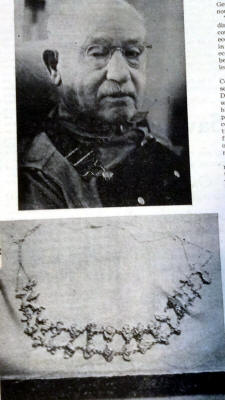Transcriber: stan@wiclarkcountyhistory.org
Surnames: Dergance, Myhrwold
----Source: Greenwood Gleaner (Greenwood, Clark Co., Wis.) 10 Sep 1964

(Written by Arvid Myhrwold)
To try to squeeze Matt Dergance into a 400 word article is something like trying to pack a bull moose into a birdcage. There is just too much to tell.
Matt lived in the state of Slovenia at the time when it was a part of Austria, ruled by Josef Hapsburg. At the age of 16, all youth were conscripted into military service, so Matt fled the country before that age, going around by "the horn" to Trieste, Prague, Vienna, and then Berlin, from whence he crossed the Atlantic to America. His brother in San Francisco sent for him, and his father gave him five dollars to last him until he was in San Francisco.
It took 8 1.2 days to cross the ocean. But once in New York City, he figured in another 3 or 4 hours he would be in San Francisco. His salami lunch became moldy on the train, so he threw it out the window, and almost starved to death during the ten-day ride across America. Besides, he laid over a whole day in Kansas City, unable to speak to anyone, all alone in the confusion of the station. But he finally reached San Francisco, and his brother.
After his brother found a job for him, he saved enough to repay his ticket, and then heard about the Gold Rush in Alaska. His brother and his boss warned him not to go, but nothing would persuade him against it, so he bought a ticket and went, with sixteen others. "People thought all they had to do was to get to Alaska, fill their sacks with gold nuggets off the ground, and go right back again, rich." But before he saw the last of Alaska, he saw these same people die like flies from starvation, scurvy and typhoid fever.
On January 24, 1896 he left San Francisco on a ship. The water was so rough that when they reached Seattle 3 1/2 days later, everyone was sick. Then four days later they were in Skagway, where they unloaded. There they were hauled up the glacier on ropes, to start the long climb up the mountain. It took three weeks to get from Skagway to the summit of the mountain, to cross over to the Yukon River. He pulled a hundred pound sack of flour on a sled; that, and his meager equipment was all he had.
But their real trouble began when they reached the lake. Nothing broke the arctic wind, which cut them bitterly. When they finally reached the Yukon, they had the problem of navigating it. So they cut logs, sawed the lumber by hand, planed the edges, and built a barge 24 feet wide and over 30 feet long. They loaded gear, the men, and their houses in it, and began to float when the ice went out. All went well until 11:00 on the night of May 23. They rounded a sharp bend, and went up on a huge boulder. The men all knelt and prayed their last prayers. Then they unloaded the horses into the stream, stripped off their clothes, and worked the raft loose by standing in the icy water. The raft moved; they rounded up the horses, built a big fire, and the next morning floated on into Dawson.
A man named Andews befriended him, and had it not been for Andrews, "Little Mat" would probably have died. But he worked on Andrews claim, for $.75 per hour, digging in a shaft. His teammate was Ole Hill. Once when they found a very rich streak, Ole stole $750 worth by filling the seams in his underwear, his boots and every place where he could stash away a few grains.
During the gold period, Matt sent back money to help his family in Austria, $4,000 worth. He staked men to "grubstake" when they were starving. They promised to pay, and many of them forgot all about ti. He still has more than $2,000 coming from these men. Altogether, he was in Alaska eight years, of which three and one-half were spent working for Andrews, who brought in a hydraulic mining outfit.
Matt has faced starvation, the Arctic darkness, the bitter polar cold, the thrill of gold, the disillusionment of the mining game. He has come many times within a hair's breath of death. He was in a Fairbanks hospital with typhoid fever for twenty-two days once, when his life hung on being able to prove that he could pay for his care there.
His last exploit was to carve out a farm from the rocks and stumps over between the mounds north of Willard, and rear his family there on the farm which still bears his name. To me he exemplifies two things: That steel-like spirit which built this country from a wilderness, and the fact that all around us are people with fascinating stores to tell, whenever someone comes with an ear. I think we have some of the most interesting people in the world, and Matt Dergance is one of them.
The necklace in the illustration is one which he made from solid gold nuggets brought from Alaska. He gave this beautiful ornament to his wife.
